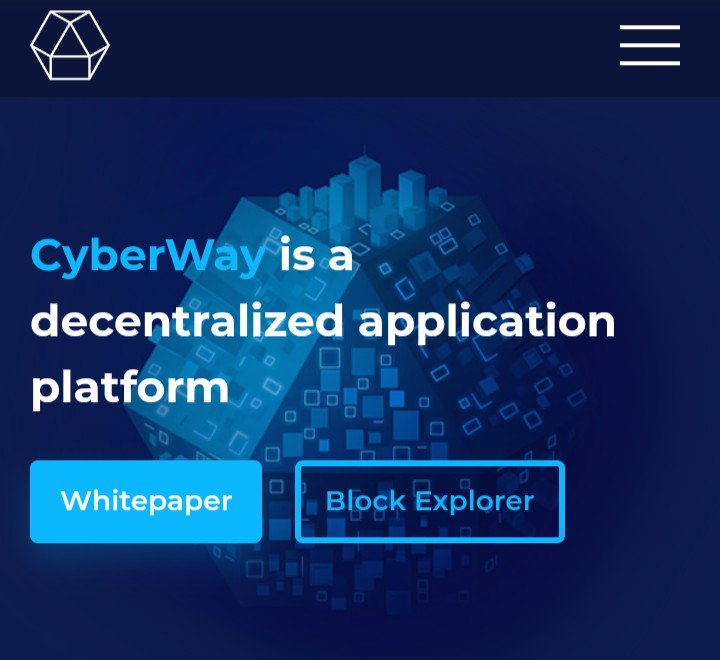
To start with, this is the CyberWay Whitepaper, you can consider and refer to it as the fork of EOS and for anyone interested in more refined comprehension of this amazing technology, please click to read in details on the link provided.
Most Blockchain users know what EOS is, so without further ado I will introduce and reintroduce you to an Upgrade to EOS with less Technical words which seems why most people do not read whitepapers to an understanding. Most people including me, I was part of the guilty party hence I figured there's a more friendlier approach is needed.
As you well know, EOS functions on DPOS- Delegated Proof-of-Stake consensus, same with Hive/Steem, Bitshares and then CyberWay. There are other consensus like Proof of Authority, BFT(Byzanite Fault Tolerance Algorithm) which Stella and Ripple works on. POS(Proof of Stake), POW(Proof Of Work) which BTC, LTC and ETH were built. ETH is poised for a migration maybe with Ether 2.0 or 4.0, its uncertain as the time I am compiling this.
These consensus came in succession after POW, each came to solve its predecessor's short comings but they all have fault and issues in the long run. So far so good, DPOS is one of the best around and it is what Hive runs upon, EOS and now CyberWay. If you know how EOS runs, it would be more easier to explain the operation and features of its upgrade.

CyberWay is a decentralized application platform that was designed to tackle and address the shortcomings of BTC, ETH and EOS combined. Most especially EOS, meaning most of EOS applications could run smoothly on CyberWay and the other way round provided the complex intolerable loopholes and shortcomings of EOS have been filtered out. Some of these complexities includes sovereignty of block producers, priority users(god accounts), limited number of block producers which is just 21 for EOS and voting(one user voting 30 times) for validators.
Digressing, DPOS consensus simply means a technology based democracy runner, where users vote and elect(delegates, witnesses, Block producers, Validators) to isolate every from of centralization from a protocol/chain and filter out malicious users.
Before going into highlights of the features that sums up CyberWay, there is a unique and distinctive characteristic that needs more emphasis. User equality, this upgrade to EOS as I illustrated doe not give room for inequalities amongst variants of users, the Blockchain assets and benefits belongs to everyone that utilize it well enough.
SOME OTHER DISTINCTIVE FEATURES
- Compatibility with EOS(to some extent).
- More decentralized than EOS because of the absence of privileged accounts and censorship.
- The primary language for application development is C++.
- Contains API Backward compatibility and smart contracts.
- Per users activity, shared bandwidth supplies users with unused computational power.
- Uses external DBMS(data base management services) for storage.
- External well designed replications and clusterisation mechanisms is available due to the future above.
- Presence of shared bandwidth that allows free and fast on boarding of multiple users.
- Block producers increasable to 101 compared to EOS 21 to ensure a truer decentralized protocol.
- Blockchain assets belongs to users, smart contracts are executed upon payments and each users could perform transactions at will.
Read more from the CyberWay Whitepaper...
All References to :
I wonder hpw many unique validators there is. 21 witnesses is alreqdy pretty hard to follow up on (meaning choosing the right one)...101 seems like a lot to ask from users and could mean less participation.
In this case, best performing validators gets rewarded and each unique users that voted for them gets a share of their own rewards, same thing goes for defaulting validators, they get some sort of fine which users that voted them in takes a share. Meaning, users gets to actively follow and monitor the validators best suited before voting them cos there is consequences for irresponsible and circle voting.
And yes, 21 is a little less compared to a more user friendly that could onboard double or triple of EOS users, meaning 101 is just a fraction when thousands and millions of active users are onboarded. Practically I don't use EOS Much cos of the unnecessarily complex technicalities, but I'm using Commun often already which indicates CyberWay easy on boarding and easy usage!
Thanks for the amazing feedback.